Strategic Asset Management Plan: Analyzing Council Truck Fleet Options
VerifiedAdded on 2023/06/08
|11
|2929
|149
Case Study
AI Summary
This document presents a strategic asset management plan (SAMP) for a local council's truck fleet, adhering to International Accounting Standard 16 (IAS-16) for asset revaluation. It evaluates various options for renewing an aging fleet of Hino trucks, including purchasing Kenworth T409, Freightliner CST112, or SinoTruk tip trucks, or renovating the existing fleet. The analysis spans from 2018 to 2022, considering factors like diesel costs, federal funding, and outsourcing. The document also includes a critical evaluation of peer discussions, highlighting strengths and weaknesses in their proposed strategies. Ultimately, the plan recommends purchasing Kenworth T409 tip trucks based on financial viability and operational factors, supported by detailed cost analysis encompassing purchase cost, servicing cost, and disposal value. The document concludes that this option offers the best balance between financial and operational efficiency for the council.
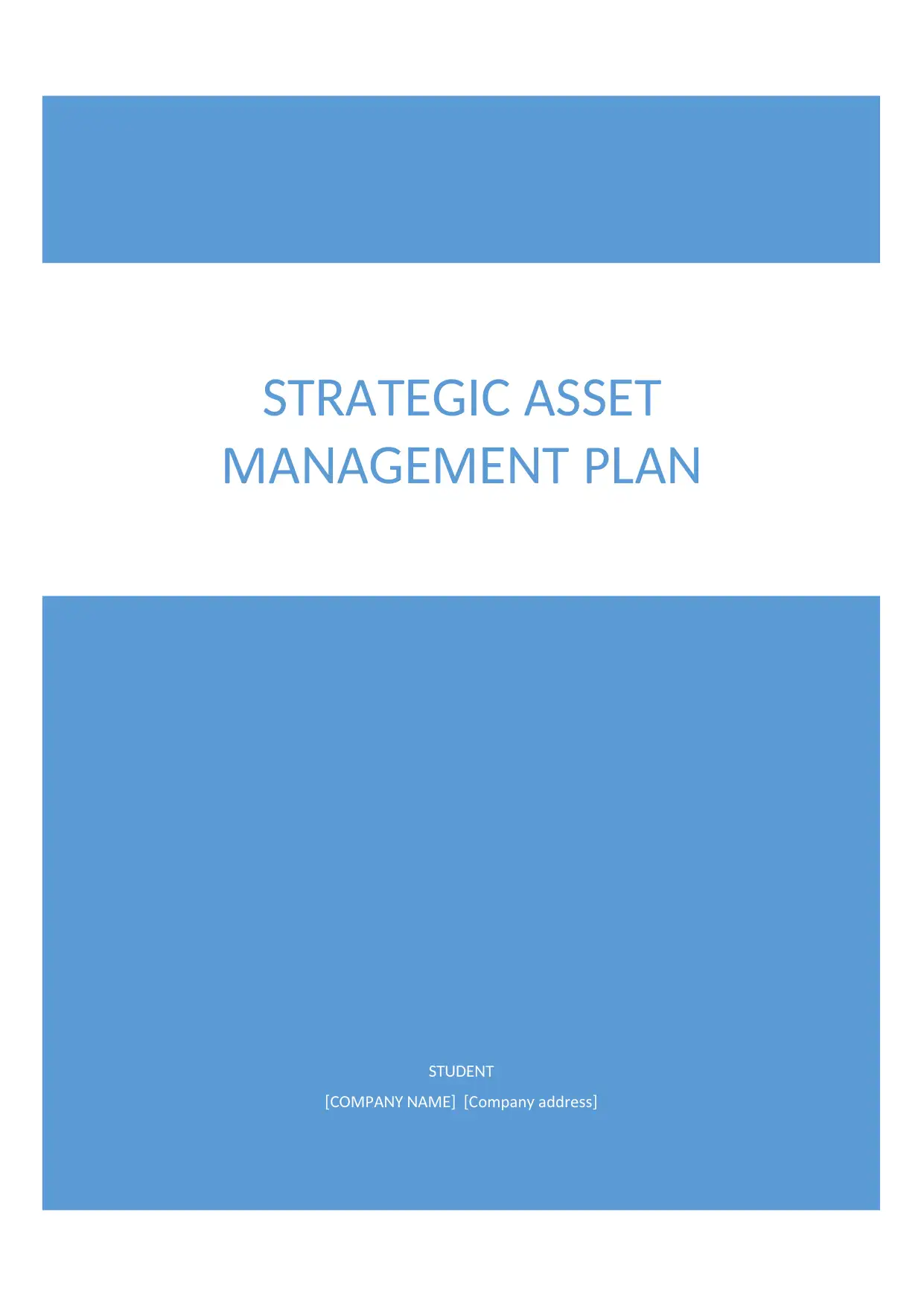
T TS UDEN
MPA AM[CO NY N E] ompan addre[C y ss]
T AT A TS R EGIC SSE
MA A M T P AN GE EN L N
MPA AM[CO NY N E] ompan addre[C y ss]
T AT A TS R EGIC SSE
MA A M T P AN GE EN L N
Paraphrase This Document
Need a fresh take? Get an instant paraphrase of this document with our AI Paraphraser
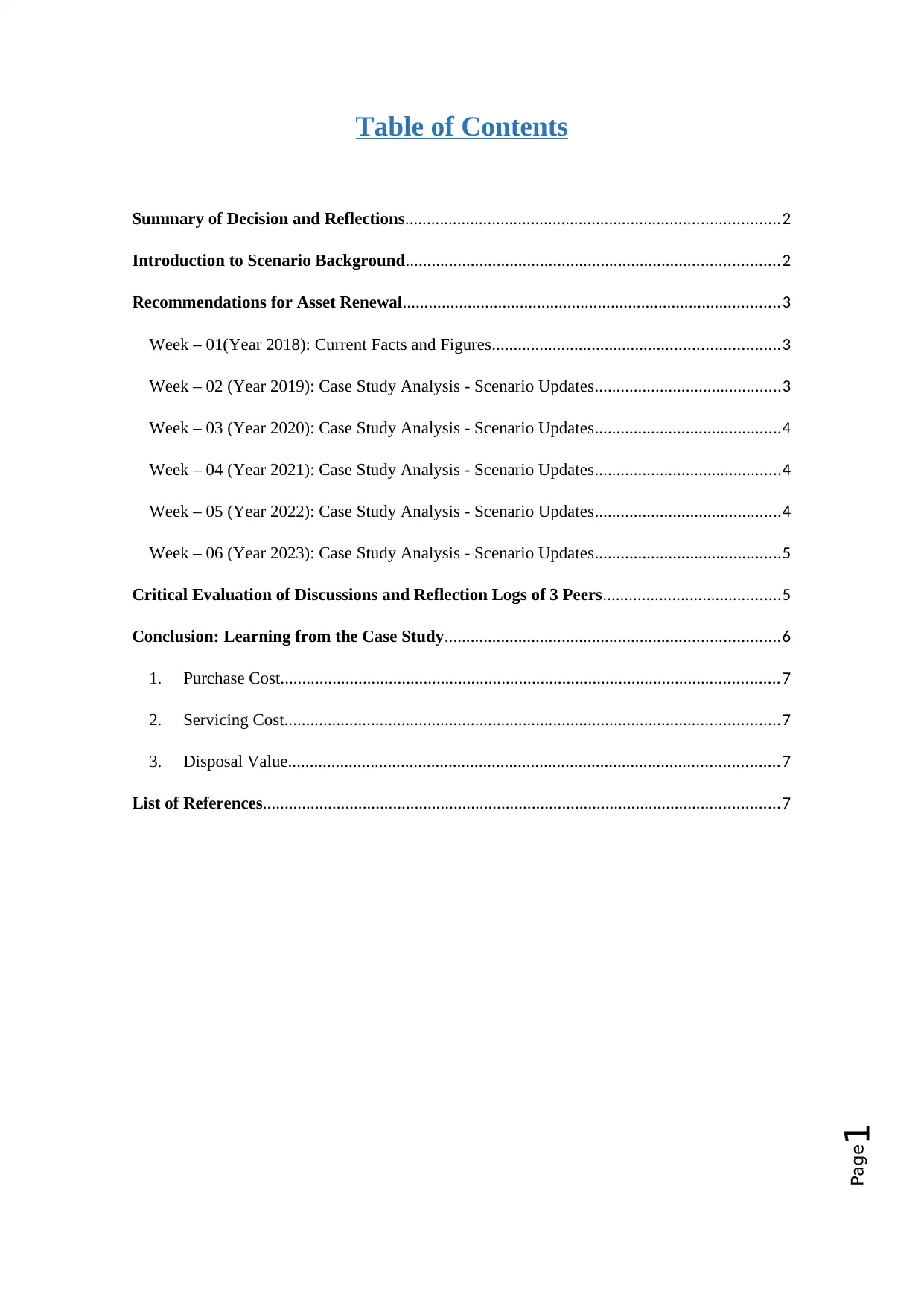
Page1
Table of Contents
Summary of Decision and Reflections......................................................................................2
Introduction to Scenario Background......................................................................................2
Recommendations for Asset Renewal.......................................................................................3
Week – 01(Year 2018): Current Facts and Figures..................................................................3
Week – 02 (Year 2019): Case Study Analysis - Scenario Updates...........................................3
Week – 03 (Year 2020): Case Study Analysis - Scenario Updates...........................................4
Week – 04 (Year 2021): Case Study Analysis - Scenario Updates...........................................4
Week – 05 (Year 2022): Case Study Analysis - Scenario Updates...........................................4
Week – 06 (Year 2023): Case Study Analysis - Scenario Updates...........................................5
Critical Evaluation of Discussions and Reflection Logs of 3 Peers.........................................5
Conclusion: Learning from the Case Study.............................................................................6
1. Purchase Cost...................................................................................................................7
2. Servicing Cost..................................................................................................................7
3. Disposal Value.................................................................................................................7
List of References.......................................................................................................................7
Table of Contents
Summary of Decision and Reflections......................................................................................2
Introduction to Scenario Background......................................................................................2
Recommendations for Asset Renewal.......................................................................................3
Week – 01(Year 2018): Current Facts and Figures..................................................................3
Week – 02 (Year 2019): Case Study Analysis - Scenario Updates...........................................3
Week – 03 (Year 2020): Case Study Analysis - Scenario Updates...........................................4
Week – 04 (Year 2021): Case Study Analysis - Scenario Updates...........................................4
Week – 05 (Year 2022): Case Study Analysis - Scenario Updates...........................................4
Week – 06 (Year 2023): Case Study Analysis - Scenario Updates...........................................5
Critical Evaluation of Discussions and Reflection Logs of 3 Peers.........................................5
Conclusion: Learning from the Case Study.............................................................................6
1. Purchase Cost...................................................................................................................7
2. Servicing Cost..................................................................................................................7
3. Disposal Value.................................................................................................................7
List of References.......................................................................................................................7
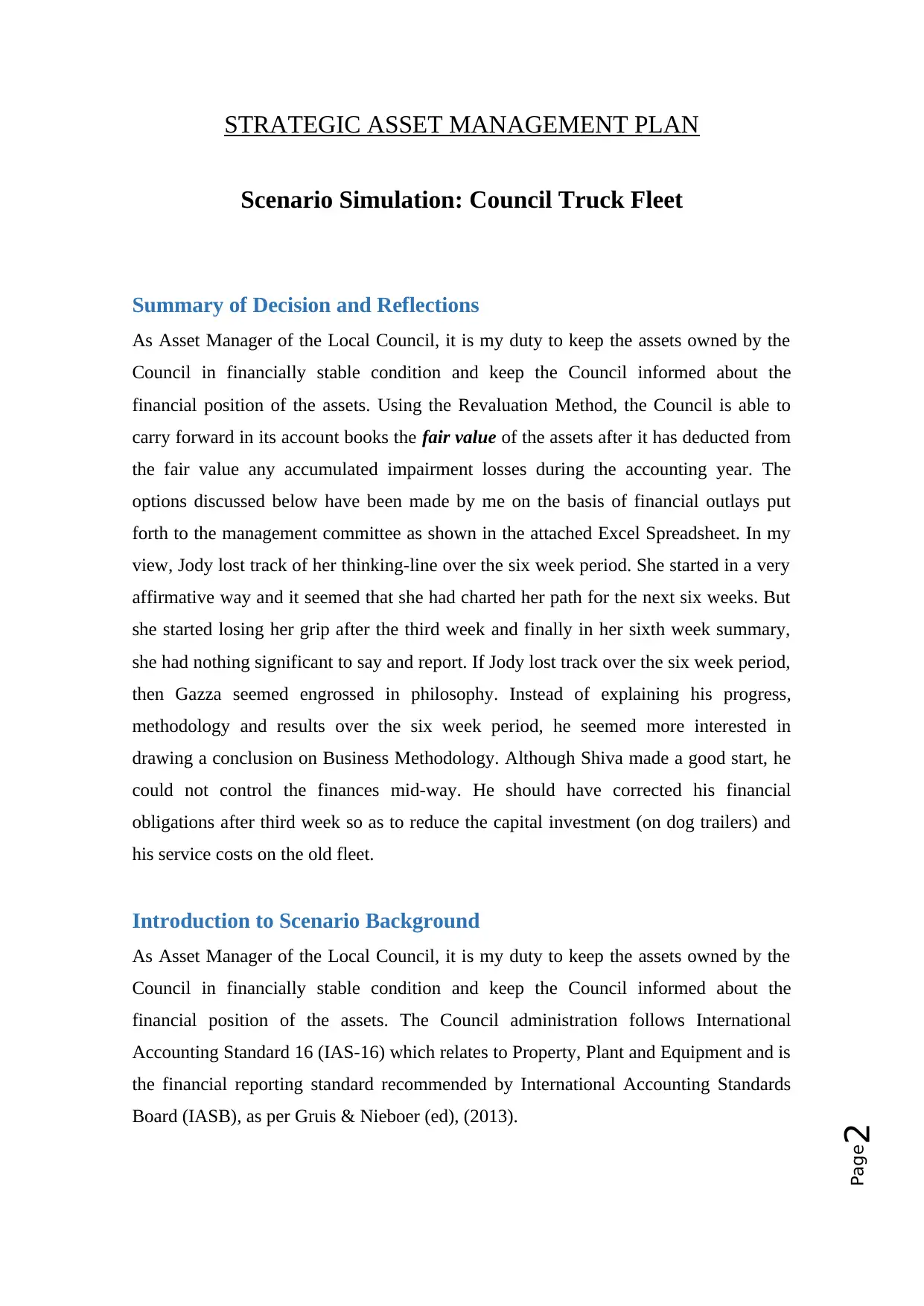
Page2
STRATEGIC ASSET MANAGEMENT PLAN
Scenario Simulation: Council Truck Fleet
Summary of Decision and Reflections
As Asset Manager of the Local Council, it is my duty to keep the assets owned by the
Council in financially stable condition and keep the Council informed about the
financial position of the assets. Using the Revaluation Method, the Council is able to
carry forward in its account books the fair value of the assets after it has deducted from
the fair value any accumulated impairment losses during the accounting year. The
options discussed below have been made by me on the basis of financial outlays put
forth to the management committee as shown in the attached Excel Spreadsheet. In my
view, Jody lost track of her thinking-line over the six week period. She started in a very
affirmative way and it seemed that she had charted her path for the next six weeks. But
she started losing her grip after the third week and finally in her sixth week summary,
she had nothing significant to say and report. If Jody lost track over the six week period,
then Gazza seemed engrossed in philosophy. Instead of explaining his progress,
methodology and results over the six week period, he seemed more interested in
drawing a conclusion on Business Methodology. Although Shiva made a good start, he
could not control the finances mid-way. He should have corrected his financial
obligations after third week so as to reduce the capital investment (on dog trailers) and
his service costs on the old fleet.
Introduction to Scenario Background
As Asset Manager of the Local Council, it is my duty to keep the assets owned by the
Council in financially stable condition and keep the Council informed about the
financial position of the assets. The Council administration follows International
Accounting Standard 16 (IAS-16) which relates to Property, Plant and Equipment and is
the financial reporting standard recommended by International Accounting Standards
Board (IASB), as per Gruis & Nieboer (ed), (2013).
STRATEGIC ASSET MANAGEMENT PLAN
Scenario Simulation: Council Truck Fleet
Summary of Decision and Reflections
As Asset Manager of the Local Council, it is my duty to keep the assets owned by the
Council in financially stable condition and keep the Council informed about the
financial position of the assets. Using the Revaluation Method, the Council is able to
carry forward in its account books the fair value of the assets after it has deducted from
the fair value any accumulated impairment losses during the accounting year. The
options discussed below have been made by me on the basis of financial outlays put
forth to the management committee as shown in the attached Excel Spreadsheet. In my
view, Jody lost track of her thinking-line over the six week period. She started in a very
affirmative way and it seemed that she had charted her path for the next six weeks. But
she started losing her grip after the third week and finally in her sixth week summary,
she had nothing significant to say and report. If Jody lost track over the six week period,
then Gazza seemed engrossed in philosophy. Instead of explaining his progress,
methodology and results over the six week period, he seemed more interested in
drawing a conclusion on Business Methodology. Although Shiva made a good start, he
could not control the finances mid-way. He should have corrected his financial
obligations after third week so as to reduce the capital investment (on dog trailers) and
his service costs on the old fleet.
Introduction to Scenario Background
As Asset Manager of the Local Council, it is my duty to keep the assets owned by the
Council in financially stable condition and keep the Council informed about the
financial position of the assets. The Council administration follows International
Accounting Standard 16 (IAS-16) which relates to Property, Plant and Equipment and is
the financial reporting standard recommended by International Accounting Standards
Board (IASB), as per Gruis & Nieboer (ed), (2013).
⊘ This is a preview!⊘
Do you want full access?
Subscribe today to unlock all pages.

Trusted by 1+ million students worldwide
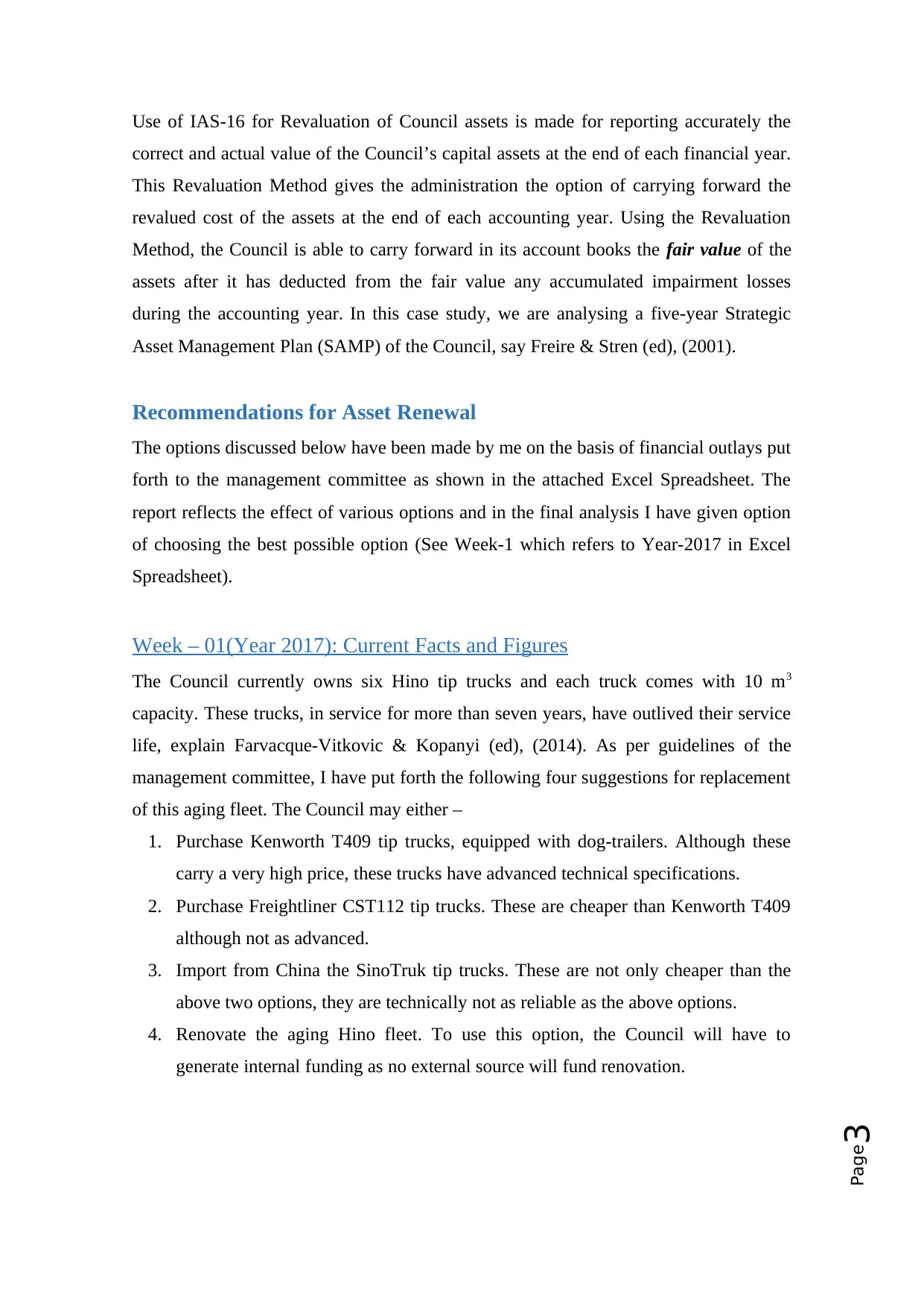
Page3
Use of IAS-16 for Revaluation of Council assets is made for reporting accurately the
correct and actual value of the Council’s capital assets at the end of each financial year.
This Revaluation Method gives the administration the option of carrying forward the
revalued cost of the assets at the end of each accounting year. Using the Revaluation
Method, the Council is able to carry forward in its account books the fair value of the
assets after it has deducted from the fair value any accumulated impairment losses
during the accounting year. In this case study, we are analysing a five-year Strategic
Asset Management Plan (SAMP) of the Council, say Freire & Stren (ed), (2001).
Recommendations for Asset Renewal
The options discussed below have been made by me on the basis of financial outlays put
forth to the management committee as shown in the attached Excel Spreadsheet. The
report reflects the effect of various options and in the final analysis I have given option
of choosing the best possible option (See Week-1 which refers to Year-2017 in Excel
Spreadsheet).
Week – 01(Year 2017): Current Facts and Figures
The Council currently owns six Hino tip trucks and each truck comes with 10 m3
capacity. These trucks, in service for more than seven years, have outlived their service
life, explain Farvacque-Vitkovic & Kopanyi (ed), (2014). As per guidelines of the
management committee, I have put forth the following four suggestions for replacement
of this aging fleet. The Council may either –
1. Purchase Kenworth T409 tip trucks, equipped with dog-trailers. Although these
carry a very high price, these trucks have advanced technical specifications.
2. Purchase Freightliner CST112 tip trucks. These are cheaper than Kenworth T409
although not as advanced.
3. Import from China the SinoTruk tip trucks. These are not only cheaper than the
above two options, they are technically not as reliable as the above options.
4. Renovate the aging Hino fleet. To use this option, the Council will have to
generate internal funding as no external source will fund renovation.
Use of IAS-16 for Revaluation of Council assets is made for reporting accurately the
correct and actual value of the Council’s capital assets at the end of each financial year.
This Revaluation Method gives the administration the option of carrying forward the
revalued cost of the assets at the end of each accounting year. Using the Revaluation
Method, the Council is able to carry forward in its account books the fair value of the
assets after it has deducted from the fair value any accumulated impairment losses
during the accounting year. In this case study, we are analysing a five-year Strategic
Asset Management Plan (SAMP) of the Council, say Freire & Stren (ed), (2001).
Recommendations for Asset Renewal
The options discussed below have been made by me on the basis of financial outlays put
forth to the management committee as shown in the attached Excel Spreadsheet. The
report reflects the effect of various options and in the final analysis I have given option
of choosing the best possible option (See Week-1 which refers to Year-2017 in Excel
Spreadsheet).
Week – 01(Year 2017): Current Facts and Figures
The Council currently owns six Hino tip trucks and each truck comes with 10 m3
capacity. These trucks, in service for more than seven years, have outlived their service
life, explain Farvacque-Vitkovic & Kopanyi (ed), (2014). As per guidelines of the
management committee, I have put forth the following four suggestions for replacement
of this aging fleet. The Council may either –
1. Purchase Kenworth T409 tip trucks, equipped with dog-trailers. Although these
carry a very high price, these trucks have advanced technical specifications.
2. Purchase Freightliner CST112 tip trucks. These are cheaper than Kenworth T409
although not as advanced.
3. Import from China the SinoTruk tip trucks. These are not only cheaper than the
above two options, they are technically not as reliable as the above options.
4. Renovate the aging Hino fleet. To use this option, the Council will have to
generate internal funding as no external source will fund renovation.
Paraphrase This Document
Need a fresh take? Get an instant paraphrase of this document with our AI Paraphraser
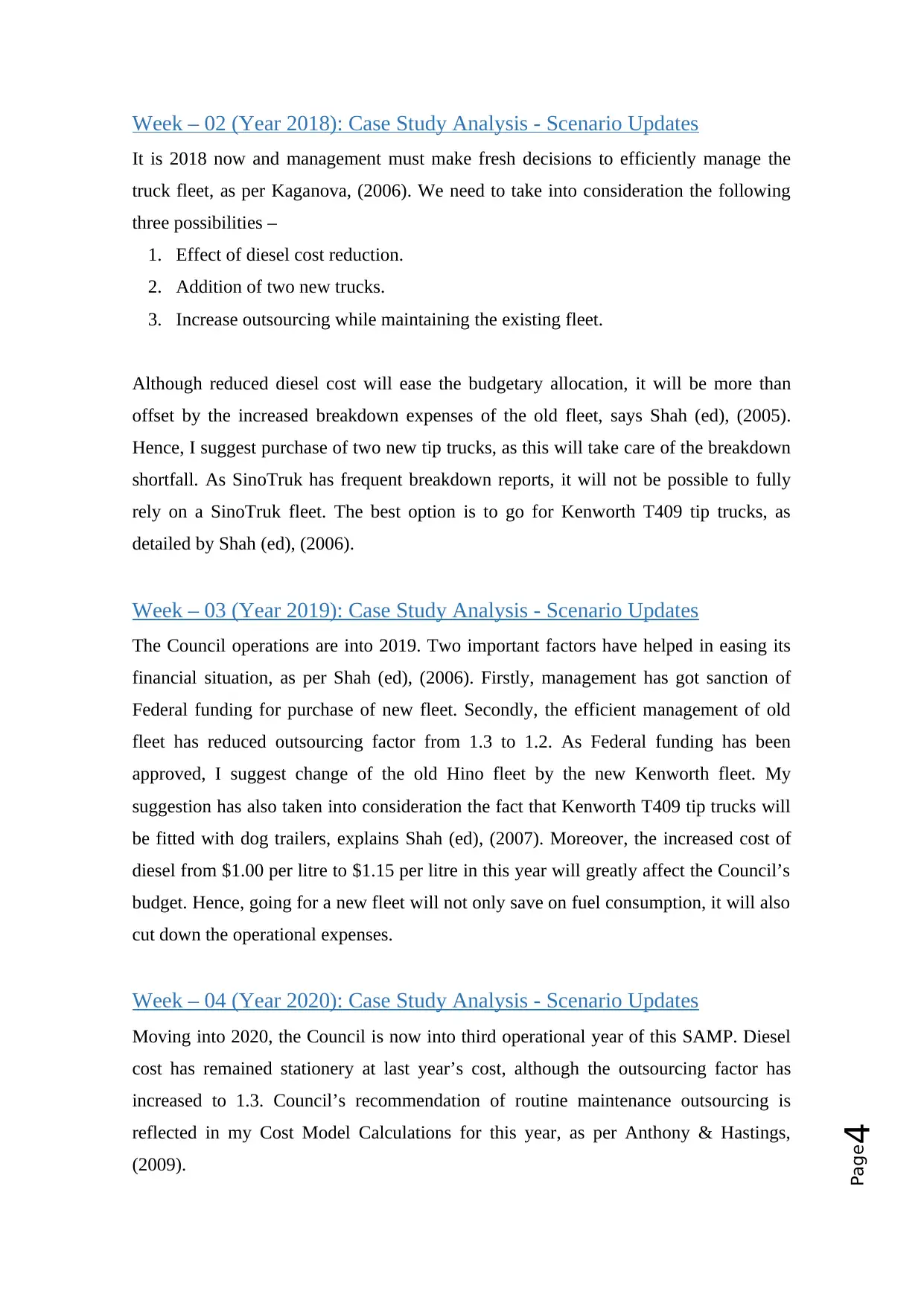
Page4
Week – 02 (Year 2018): Case Study Analysis - Scenario Updates
It is 2018 now and management must make fresh decisions to efficiently manage the
truck fleet, as per Kaganova, (2006). We need to take into consideration the following
three possibilities –
1. Effect of diesel cost reduction.
2. Addition of two new trucks.
3. Increase outsourcing while maintaining the existing fleet.
Although reduced diesel cost will ease the budgetary allocation, it will be more than
offset by the increased breakdown expenses of the old fleet, says Shah (ed), (2005).
Hence, I suggest purchase of two new tip trucks, as this will take care of the breakdown
shortfall. As SinoTruk has frequent breakdown reports, it will not be possible to fully
rely on a SinoTruk fleet. The best option is to go for Kenworth T409 tip trucks, as
detailed by Shah (ed), (2006).
Week – 03 (Year 2019): Case Study Analysis - Scenario Updates
The Council operations are into 2019. Two important factors have helped in easing its
financial situation, as per Shah (ed), (2006). Firstly, management has got sanction of
Federal funding for purchase of new fleet. Secondly, the efficient management of old
fleet has reduced outsourcing factor from 1.3 to 1.2. As Federal funding has been
approved, I suggest change of the old Hino fleet by the new Kenworth fleet. My
suggestion has also taken into consideration the fact that Kenworth T409 tip trucks will
be fitted with dog trailers, explains Shah (ed), (2007). Moreover, the increased cost of
diesel from $1.00 per litre to $1.15 per litre in this year will greatly affect the Council’s
budget. Hence, going for a new fleet will not only save on fuel consumption, it will also
cut down the operational expenses.
Week – 04 (Year 2020): Case Study Analysis - Scenario Updates
Moving into 2020, the Council is now into third operational year of this SAMP. Diesel
cost has remained stationery at last year’s cost, although the outsourcing factor has
increased to 1.3. Council’s recommendation of routine maintenance outsourcing is
reflected in my Cost Model Calculations for this year, as per Anthony & Hastings,
(2009).
Week – 02 (Year 2018): Case Study Analysis - Scenario Updates
It is 2018 now and management must make fresh decisions to efficiently manage the
truck fleet, as per Kaganova, (2006). We need to take into consideration the following
three possibilities –
1. Effect of diesel cost reduction.
2. Addition of two new trucks.
3. Increase outsourcing while maintaining the existing fleet.
Although reduced diesel cost will ease the budgetary allocation, it will be more than
offset by the increased breakdown expenses of the old fleet, says Shah (ed), (2005).
Hence, I suggest purchase of two new tip trucks, as this will take care of the breakdown
shortfall. As SinoTruk has frequent breakdown reports, it will not be possible to fully
rely on a SinoTruk fleet. The best option is to go for Kenworth T409 tip trucks, as
detailed by Shah (ed), (2006).
Week – 03 (Year 2019): Case Study Analysis - Scenario Updates
The Council operations are into 2019. Two important factors have helped in easing its
financial situation, as per Shah (ed), (2006). Firstly, management has got sanction of
Federal funding for purchase of new fleet. Secondly, the efficient management of old
fleet has reduced outsourcing factor from 1.3 to 1.2. As Federal funding has been
approved, I suggest change of the old Hino fleet by the new Kenworth fleet. My
suggestion has also taken into consideration the fact that Kenworth T409 tip trucks will
be fitted with dog trailers, explains Shah (ed), (2007). Moreover, the increased cost of
diesel from $1.00 per litre to $1.15 per litre in this year will greatly affect the Council’s
budget. Hence, going for a new fleet will not only save on fuel consumption, it will also
cut down the operational expenses.
Week – 04 (Year 2020): Case Study Analysis - Scenario Updates
Moving into 2020, the Council is now into third operational year of this SAMP. Diesel
cost has remained stationery at last year’s cost, although the outsourcing factor has
increased to 1.3. Council’s recommendation of routine maintenance outsourcing is
reflected in my Cost Model Calculations for this year, as per Anthony & Hastings,
(2009).
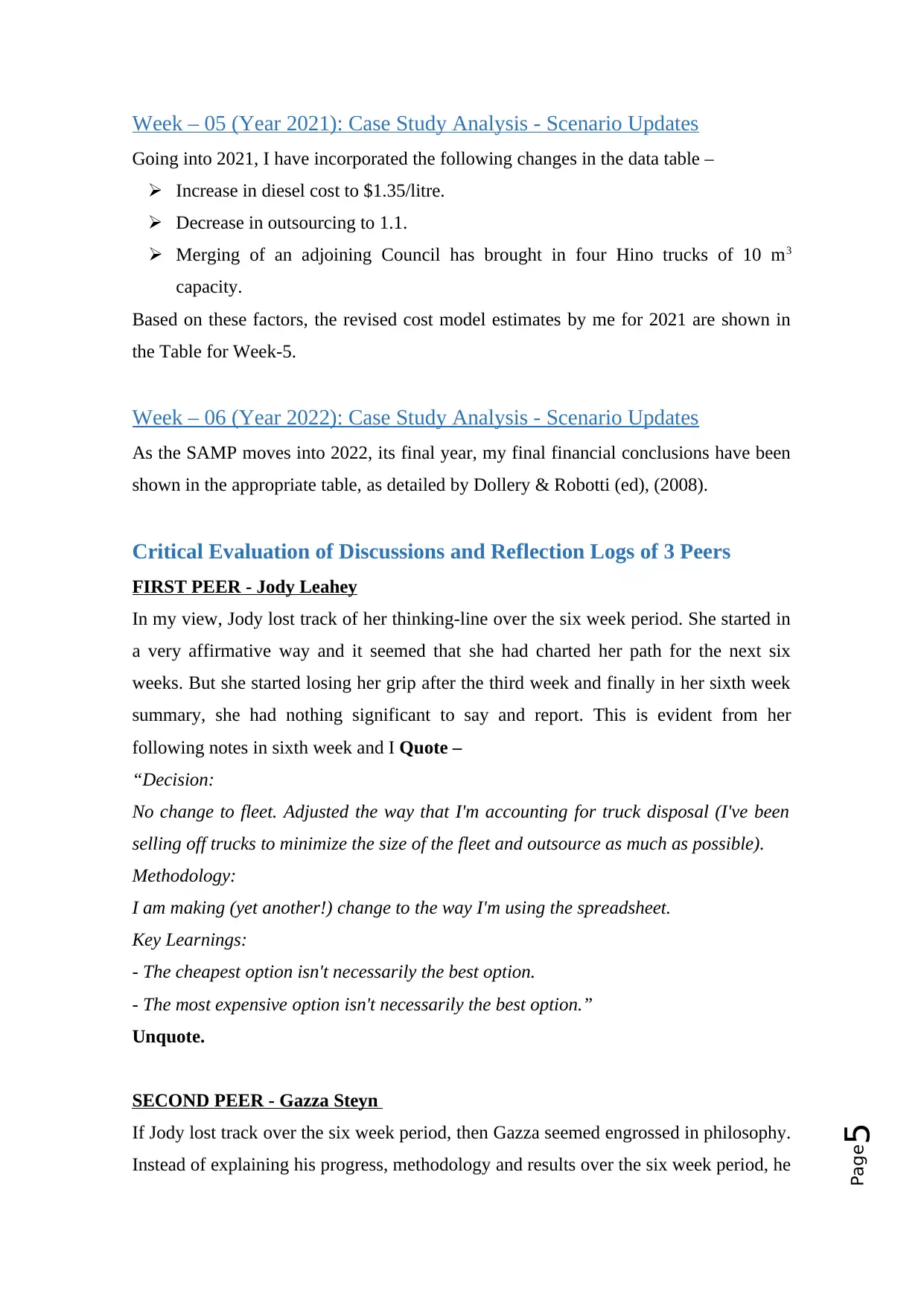
Page5
Week – 05 (Year 2021): Case Study Analysis - Scenario Updates
Going into 2021, I have incorporated the following changes in the data table –
Increase in diesel cost to $1.35/litre.
Decrease in outsourcing to 1.1.
Merging of an adjoining Council has brought in four Hino trucks of 10 m3
capacity.
Based on these factors, the revised cost model estimates by me for 2021 are shown in
the Table for Week-5.
Week – 06 (Year 2022): Case Study Analysis - Scenario Updates
As the SAMP moves into 2022, its final year, my final financial conclusions have been
shown in the appropriate table, as detailed by Dollery & Robotti (ed), (2008).
Critical Evaluation of Discussions and Reflection Logs of 3 Peers
FIRST PEER - Jody Leahey
In my view, Jody lost track of her thinking-line over the six week period. She started in
a very affirmative way and it seemed that she had charted her path for the next six
weeks. But she started losing her grip after the third week and finally in her sixth week
summary, she had nothing significant to say and report. This is evident from her
following notes in sixth week and I Quote –
“Decision:
No change to fleet. Adjusted the way that I'm accounting for truck disposal (I've been
selling off trucks to minimize the size of the fleet and outsource as much as possible).
Methodology:
I am making (yet another!) change to the way I'm using the spreadsheet.
Key Learnings:
- The cheapest option isn't necessarily the best option.
- The most expensive option isn't necessarily the best option.”
Unquote.
SECOND PEER - Gazza Steyn
If Jody lost track over the six week period, then Gazza seemed engrossed in philosophy.
Instead of explaining his progress, methodology and results over the six week period, he
Week – 05 (Year 2021): Case Study Analysis - Scenario Updates
Going into 2021, I have incorporated the following changes in the data table –
Increase in diesel cost to $1.35/litre.
Decrease in outsourcing to 1.1.
Merging of an adjoining Council has brought in four Hino trucks of 10 m3
capacity.
Based on these factors, the revised cost model estimates by me for 2021 are shown in
the Table for Week-5.
Week – 06 (Year 2022): Case Study Analysis - Scenario Updates
As the SAMP moves into 2022, its final year, my final financial conclusions have been
shown in the appropriate table, as detailed by Dollery & Robotti (ed), (2008).
Critical Evaluation of Discussions and Reflection Logs of 3 Peers
FIRST PEER - Jody Leahey
In my view, Jody lost track of her thinking-line over the six week period. She started in
a very affirmative way and it seemed that she had charted her path for the next six
weeks. But she started losing her grip after the third week and finally in her sixth week
summary, she had nothing significant to say and report. This is evident from her
following notes in sixth week and I Quote –
“Decision:
No change to fleet. Adjusted the way that I'm accounting for truck disposal (I've been
selling off trucks to minimize the size of the fleet and outsource as much as possible).
Methodology:
I am making (yet another!) change to the way I'm using the spreadsheet.
Key Learnings:
- The cheapest option isn't necessarily the best option.
- The most expensive option isn't necessarily the best option.”
Unquote.
SECOND PEER - Gazza Steyn
If Jody lost track over the six week period, then Gazza seemed engrossed in philosophy.
Instead of explaining his progress, methodology and results over the six week period, he
⊘ This is a preview!⊘
Do you want full access?
Subscribe today to unlock all pages.

Trusted by 1+ million students worldwide
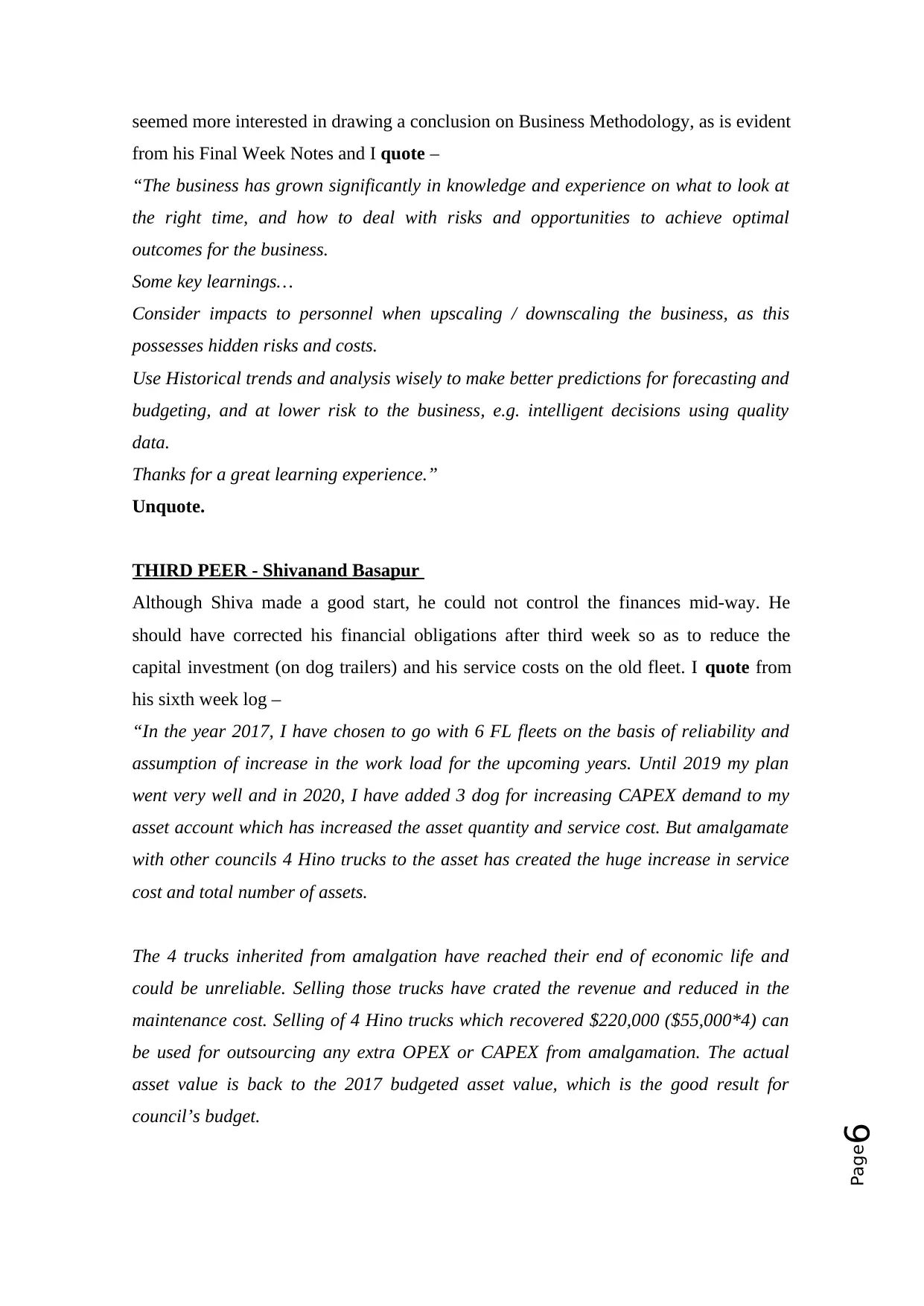
Page6
seemed more interested in drawing a conclusion on Business Methodology, as is evident
from his Final Week Notes and I quote –
“The business has grown significantly in knowledge and experience on what to look at
the right time, and how to deal with risks and opportunities to achieve optimal
outcomes for the business.
Some key learnings…
Consider impacts to personnel when upscaling / downscaling the business, as this
possesses hidden risks and costs.
Use Historical trends and analysis wisely to make better predictions for forecasting and
budgeting, and at lower risk to the business, e.g. intelligent decisions using quality
data.
Thanks for a great learning experience.”
Unquote.
THIRD PEER - Shivanand Basapur
Although Shiva made a good start, he could not control the finances mid-way. He
should have corrected his financial obligations after third week so as to reduce the
capital investment (on dog trailers) and his service costs on the old fleet. I quote from
his sixth week log –
“In the year 2017, I have chosen to go with 6 FL fleets on the basis of reliability and
assumption of increase in the work load for the upcoming years. Until 2019 my plan
went very well and in 2020, I have added 3 dog for increasing CAPEX demand to my
asset account which has increased the asset quantity and service cost. But amalgamate
with other councils 4 Hino trucks to the asset has created the huge increase in service
cost and total number of assets.
The 4 trucks inherited from amalgation have reached their end of economic life and
could be unreliable. Selling those trucks have crated the revenue and reduced in the
maintenance cost. Selling of 4 Hino trucks which recovered $220,000 ($55,000*4) can
be used for outsourcing any extra OPEX or CAPEX from amalgamation. The actual
asset value is back to the 2017 budgeted asset value, which is the good result for
council’s budget.
seemed more interested in drawing a conclusion on Business Methodology, as is evident
from his Final Week Notes and I quote –
“The business has grown significantly in knowledge and experience on what to look at
the right time, and how to deal with risks and opportunities to achieve optimal
outcomes for the business.
Some key learnings…
Consider impacts to personnel when upscaling / downscaling the business, as this
possesses hidden risks and costs.
Use Historical trends and analysis wisely to make better predictions for forecasting and
budgeting, and at lower risk to the business, e.g. intelligent decisions using quality
data.
Thanks for a great learning experience.”
Unquote.
THIRD PEER - Shivanand Basapur
Although Shiva made a good start, he could not control the finances mid-way. He
should have corrected his financial obligations after third week so as to reduce the
capital investment (on dog trailers) and his service costs on the old fleet. I quote from
his sixth week log –
“In the year 2017, I have chosen to go with 6 FL fleets on the basis of reliability and
assumption of increase in the work load for the upcoming years. Until 2019 my plan
went very well and in 2020, I have added 3 dog for increasing CAPEX demand to my
asset account which has increased the asset quantity and service cost. But amalgamate
with other councils 4 Hino trucks to the asset has created the huge increase in service
cost and total number of assets.
The 4 trucks inherited from amalgation have reached their end of economic life and
could be unreliable. Selling those trucks have crated the revenue and reduced in the
maintenance cost. Selling of 4 Hino trucks which recovered $220,000 ($55,000*4) can
be used for outsourcing any extra OPEX or CAPEX from amalgamation. The actual
asset value is back to the 2017 budgeted asset value, which is the good result for
council’s budget.
Paraphrase This Document
Need a fresh take? Get an instant paraphrase of this document with our AI Paraphraser
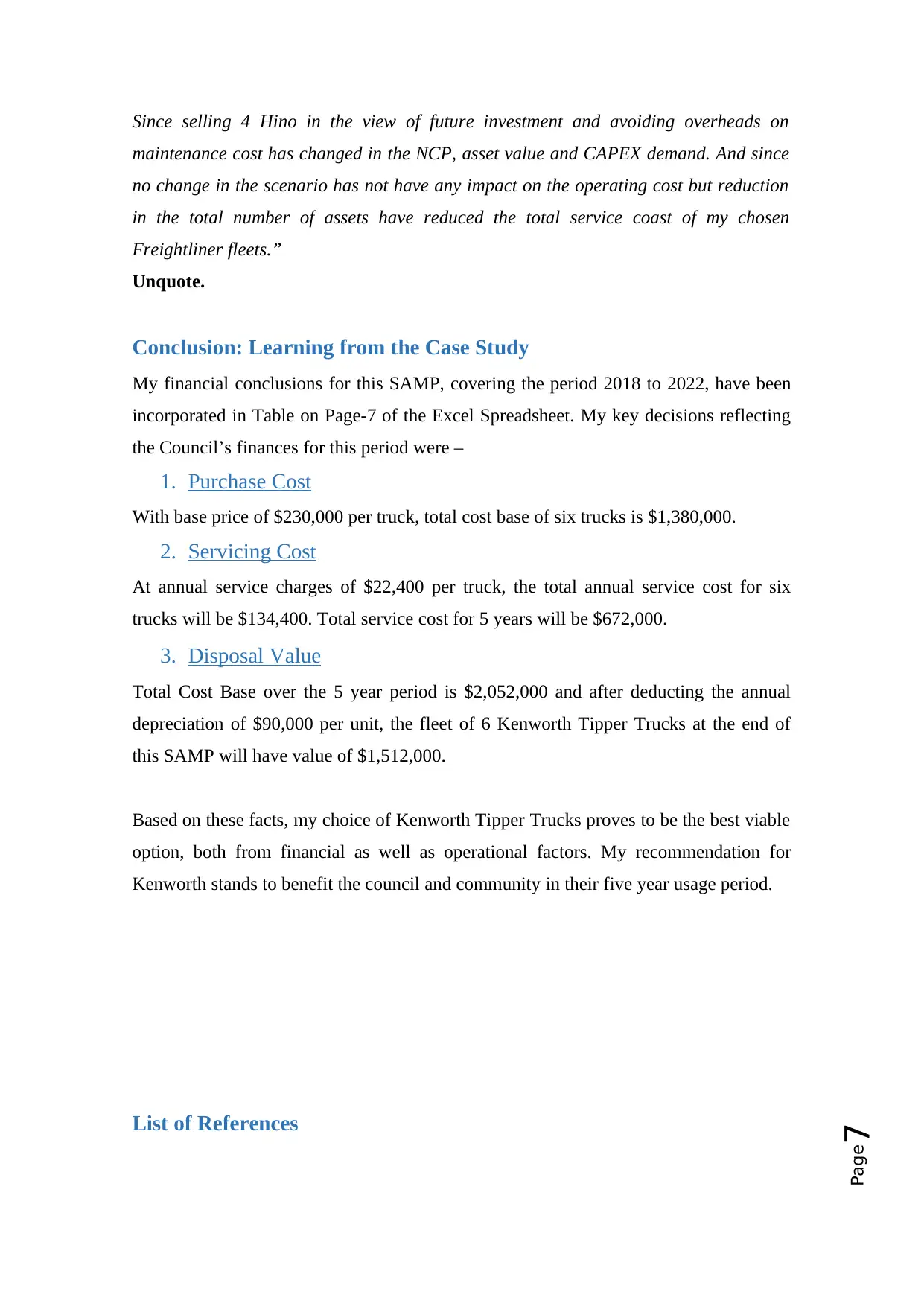
Page7
Since selling 4 Hino in the view of future investment and avoiding overheads on
maintenance cost has changed in the NCP, asset value and CAPEX demand. And since
no change in the scenario has not have any impact on the operating cost but reduction
in the total number of assets have reduced the total service coast of my chosen
Freightliner fleets.”
Unquote.
Conclusion: Learning from the Case Study
My financial conclusions for this SAMP, covering the period 2018 to 2022, have been
incorporated in Table on Page-7 of the Excel Spreadsheet. My key decisions reflecting
the Council’s finances for this period were –
1. Purchase Cost
With base price of $230,000 per truck, total cost base of six trucks is $1,380,000.
2. Servicing Cost
At annual service charges of $22,400 per truck, the total annual service cost for six
trucks will be $134,400. Total service cost for 5 years will be $672,000.
3. Disposal Value
Total Cost Base over the 5 year period is $2,052,000 and after deducting the annual
depreciation of $90,000 per unit, the fleet of 6 Kenworth Tipper Trucks at the end of
this SAMP will have value of $1,512,000.
Based on these facts, my choice of Kenworth Tipper Trucks proves to be the best viable
option, both from financial as well as operational factors. My recommendation for
Kenworth stands to benefit the council and community in their five year usage period.
List of References
Since selling 4 Hino in the view of future investment and avoiding overheads on
maintenance cost has changed in the NCP, asset value and CAPEX demand. And since
no change in the scenario has not have any impact on the operating cost but reduction
in the total number of assets have reduced the total service coast of my chosen
Freightliner fleets.”
Unquote.
Conclusion: Learning from the Case Study
My financial conclusions for this SAMP, covering the period 2018 to 2022, have been
incorporated in Table on Page-7 of the Excel Spreadsheet. My key decisions reflecting
the Council’s finances for this period were –
1. Purchase Cost
With base price of $230,000 per truck, total cost base of six trucks is $1,380,000.
2. Servicing Cost
At annual service charges of $22,400 per truck, the total annual service cost for six
trucks will be $134,400. Total service cost for 5 years will be $672,000.
3. Disposal Value
Total Cost Base over the 5 year period is $2,052,000 and after deducting the annual
depreciation of $90,000 per unit, the fleet of 6 Kenworth Tipper Trucks at the end of
this SAMP will have value of $1,512,000.
Based on these facts, my choice of Kenworth Tipper Trucks proves to be the best viable
option, both from financial as well as operational factors. My recommendation for
Kenworth stands to benefit the council and community in their five year usage period.
List of References
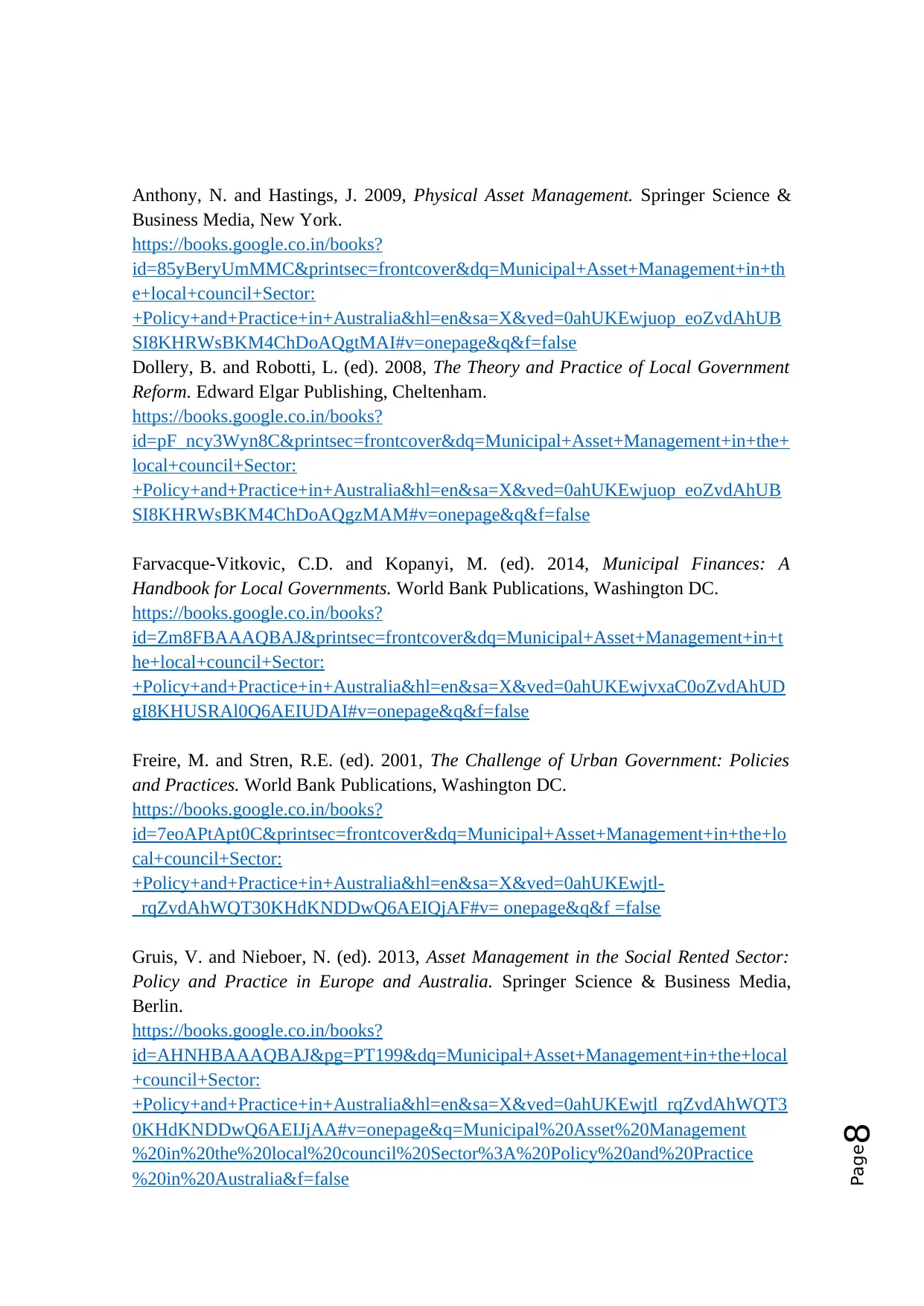
Page8
Anthony, N. and Hastings, J. 2009, Physical Asset Management. Springer Science &
Business Media, New York.
https://books.google.co.in/books?
id=85yBeryUmMMC&printsec=frontcover&dq=Municipal+Asset+Management+in+th
e+local+council+Sector:
+Policy+and+Practice+in+Australia&hl=en&sa=X&ved=0ahUKEwjuop_eoZvdAhUB
SI8KHRWsBKM4ChDoAQgtMAI#v=onepage&q&f=false
Dollery, B. and Robotti, L. (ed). 2008, The Theory and Practice of Local Government
Reform. Edward Elgar Publishing, Cheltenham.
https://books.google.co.in/books?
id=pF_ncy3Wyn8C&printsec=frontcover&dq=Municipal+Asset+Management+in+the+
local+council+Sector:
+Policy+and+Practice+in+Australia&hl=en&sa=X&ved=0ahUKEwjuop_eoZvdAhUB
SI8KHRWsBKM4ChDoAQgzMAM#v=onepage&q&f=false
Farvacque-Vitkovic, C.D. and Kopanyi, M. (ed). 2014, Municipal Finances: A
Handbook for Local Governments. World Bank Publications, Washington DC.
https://books.google.co.in/books?
id=Zm8FBAAAQBAJ&printsec=frontcover&dq=Municipal+Asset+Management+in+t
he+local+council+Sector:
+Policy+and+Practice+in+Australia&hl=en&sa=X&ved=0ahUKEwjvxaC0oZvdAhUD
gI8KHUSRAl0Q6AEIUDAI#v=onepage&q&f=false
Freire, M. and Stren, R.E. (ed). 2001, The Challenge of Urban Government: Policies
and Practices. World Bank Publications, Washington DC.
https://books.google.co.in/books?
id=7eoAPtApt0C&printsec=frontcover&dq=Municipal+Asset+Management+in+the+lo
cal+council+Sector:
+Policy+and+Practice+in+Australia&hl=en&sa=X&ved=0ahUKEwjtl-
_rqZvdAhWQT30KHdKNDDwQ6AEIQjAF#v= onepage&q&f =false
Gruis, V. and Nieboer, N. (ed). 2013, Asset Management in the Social Rented Sector:
Policy and Practice in Europe and Australia. Springer Science & Business Media,
Berlin.
https://books.google.co.in/books?
id=AHNHBAAAQBAJ&pg=PT199&dq=Municipal+Asset+Management+in+the+local
+council+Sector:
+Policy+and+Practice+in+Australia&hl=en&sa=X&ved=0ahUKEwjtl_rqZvdAhWQT3
0KHdKNDDwQ6AEIJjAA#v=onepage&q=Municipal%20Asset%20Management
%20in%20the%20local%20council%20Sector%3A%20Policy%20and%20Practice
%20in%20Australia&f=false
Anthony, N. and Hastings, J. 2009, Physical Asset Management. Springer Science &
Business Media, New York.
https://books.google.co.in/books?
id=85yBeryUmMMC&printsec=frontcover&dq=Municipal+Asset+Management+in+th
e+local+council+Sector:
+Policy+and+Practice+in+Australia&hl=en&sa=X&ved=0ahUKEwjuop_eoZvdAhUB
SI8KHRWsBKM4ChDoAQgtMAI#v=onepage&q&f=false
Dollery, B. and Robotti, L. (ed). 2008, The Theory and Practice of Local Government
Reform. Edward Elgar Publishing, Cheltenham.
https://books.google.co.in/books?
id=pF_ncy3Wyn8C&printsec=frontcover&dq=Municipal+Asset+Management+in+the+
local+council+Sector:
+Policy+and+Practice+in+Australia&hl=en&sa=X&ved=0ahUKEwjuop_eoZvdAhUB
SI8KHRWsBKM4ChDoAQgzMAM#v=onepage&q&f=false
Farvacque-Vitkovic, C.D. and Kopanyi, M. (ed). 2014, Municipal Finances: A
Handbook for Local Governments. World Bank Publications, Washington DC.
https://books.google.co.in/books?
id=Zm8FBAAAQBAJ&printsec=frontcover&dq=Municipal+Asset+Management+in+t
he+local+council+Sector:
+Policy+and+Practice+in+Australia&hl=en&sa=X&ved=0ahUKEwjvxaC0oZvdAhUD
gI8KHUSRAl0Q6AEIUDAI#v=onepage&q&f=false
Freire, M. and Stren, R.E. (ed). 2001, The Challenge of Urban Government: Policies
and Practices. World Bank Publications, Washington DC.
https://books.google.co.in/books?
id=7eoAPtApt0C&printsec=frontcover&dq=Municipal+Asset+Management+in+the+lo
cal+council+Sector:
+Policy+and+Practice+in+Australia&hl=en&sa=X&ved=0ahUKEwjtl-
_rqZvdAhWQT30KHdKNDDwQ6AEIQjAF#v= onepage&q&f =false
Gruis, V. and Nieboer, N. (ed). 2013, Asset Management in the Social Rented Sector:
Policy and Practice in Europe and Australia. Springer Science & Business Media,
Berlin.
https://books.google.co.in/books?
id=AHNHBAAAQBAJ&pg=PT199&dq=Municipal+Asset+Management+in+the+local
+council+Sector:
+Policy+and+Practice+in+Australia&hl=en&sa=X&ved=0ahUKEwjtl_rqZvdAhWQT3
0KHdKNDDwQ6AEIJjAA#v=onepage&q=Municipal%20Asset%20Management
%20in%20the%20local%20council%20Sector%3A%20Policy%20and%20Practice
%20in%20Australia&f=false
⊘ This is a preview!⊘
Do you want full access?
Subscribe today to unlock all pages.

Trusted by 1+ million students worldwide
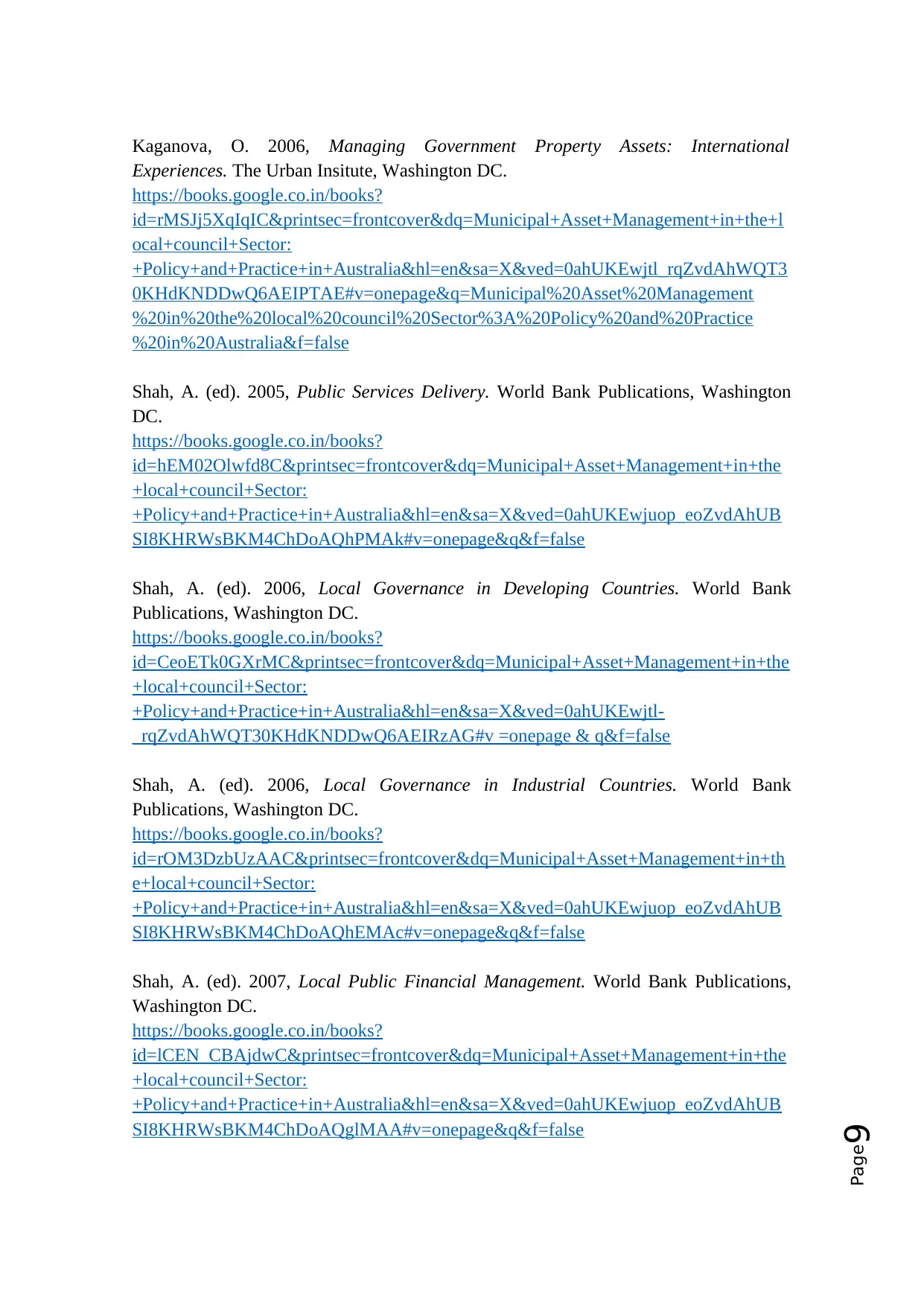
Page9
Kaganova, O. 2006, Managing Government Property Assets: International
Experiences. The Urban Insitute, Washington DC.
https://books.google.co.in/books?
id=rMSJj5XqIqIC&printsec=frontcover&dq=Municipal+Asset+Management+in+the+l
ocal+council+Sector:
+Policy+and+Practice+in+Australia&hl=en&sa=X&ved=0ahUKEwjtl_rqZvdAhWQT3
0KHdKNDDwQ6AEIPTAE#v=onepage&q=Municipal%20Asset%20Management
%20in%20the%20local%20council%20Sector%3A%20Policy%20and%20Practice
%20in%20Australia&f=false
Shah, A. (ed). 2005, Public Services Delivery. World Bank Publications, Washington
DC.
https://books.google.co.in/books?
id=hEM02Olwfd8C&printsec=frontcover&dq=Municipal+Asset+Management+in+the
+local+council+Sector:
+Policy+and+Practice+in+Australia&hl=en&sa=X&ved=0ahUKEwjuop_eoZvdAhUB
SI8KHRWsBKM4ChDoAQhPMAk#v=onepage&q&f=false
Shah, A. (ed). 2006, Local Governance in Developing Countries. World Bank
Publications, Washington DC.
https://books.google.co.in/books?
id=CeoETk0GXrMC&printsec=frontcover&dq=Municipal+Asset+Management+in+the
+local+council+Sector:
+Policy+and+Practice+in+Australia&hl=en&sa=X&ved=0ahUKEwjtl-
_rqZvdAhWQT30KHdKNDDwQ6AEIRzAG#v =onepage & q&f=false
Shah, A. (ed). 2006, Local Governance in Industrial Countries. World Bank
Publications, Washington DC.
https://books.google.co.in/books?
id=rOM3DzbUzAAC&printsec=frontcover&dq=Municipal+Asset+Management+in+th
e+local+council+Sector:
+Policy+and+Practice+in+Australia&hl=en&sa=X&ved=0ahUKEwjuop_eoZvdAhUB
SI8KHRWsBKM4ChDoAQhEMAc#v=onepage&q&f=false
Shah, A. (ed). 2007, Local Public Financial Management. World Bank Publications,
Washington DC.
https://books.google.co.in/books?
id=lCEN_CBAjdwC&printsec=frontcover&dq=Municipal+Asset+Management+in+the
+local+council+Sector:
+Policy+and+Practice+in+Australia&hl=en&sa=X&ved=0ahUKEwjuop_eoZvdAhUB
SI8KHRWsBKM4ChDoAQglMAA#v=onepage&q&f=false
Kaganova, O. 2006, Managing Government Property Assets: International
Experiences. The Urban Insitute, Washington DC.
https://books.google.co.in/books?
id=rMSJj5XqIqIC&printsec=frontcover&dq=Municipal+Asset+Management+in+the+l
ocal+council+Sector:
+Policy+and+Practice+in+Australia&hl=en&sa=X&ved=0ahUKEwjtl_rqZvdAhWQT3
0KHdKNDDwQ6AEIPTAE#v=onepage&q=Municipal%20Asset%20Management
%20in%20the%20local%20council%20Sector%3A%20Policy%20and%20Practice
%20in%20Australia&f=false
Shah, A. (ed). 2005, Public Services Delivery. World Bank Publications, Washington
DC.
https://books.google.co.in/books?
id=hEM02Olwfd8C&printsec=frontcover&dq=Municipal+Asset+Management+in+the
+local+council+Sector:
+Policy+and+Practice+in+Australia&hl=en&sa=X&ved=0ahUKEwjuop_eoZvdAhUB
SI8KHRWsBKM4ChDoAQhPMAk#v=onepage&q&f=false
Shah, A. (ed). 2006, Local Governance in Developing Countries. World Bank
Publications, Washington DC.
https://books.google.co.in/books?
id=CeoETk0GXrMC&printsec=frontcover&dq=Municipal+Asset+Management+in+the
+local+council+Sector:
+Policy+and+Practice+in+Australia&hl=en&sa=X&ved=0ahUKEwjtl-
_rqZvdAhWQT30KHdKNDDwQ6AEIRzAG#v =onepage & q&f=false
Shah, A. (ed). 2006, Local Governance in Industrial Countries. World Bank
Publications, Washington DC.
https://books.google.co.in/books?
id=rOM3DzbUzAAC&printsec=frontcover&dq=Municipal+Asset+Management+in+th
e+local+council+Sector:
+Policy+and+Practice+in+Australia&hl=en&sa=X&ved=0ahUKEwjuop_eoZvdAhUB
SI8KHRWsBKM4ChDoAQhEMAc#v=onepage&q&f=false
Shah, A. (ed). 2007, Local Public Financial Management. World Bank Publications,
Washington DC.
https://books.google.co.in/books?
id=lCEN_CBAjdwC&printsec=frontcover&dq=Municipal+Asset+Management+in+the
+local+council+Sector:
+Policy+and+Practice+in+Australia&hl=en&sa=X&ved=0ahUKEwjuop_eoZvdAhUB
SI8KHRWsBKM4ChDoAQglMAA#v=onepage&q&f=false
Paraphrase This Document
Need a fresh take? Get an instant paraphrase of this document with our AI Paraphraser

Page10
1 out of 11
Your All-in-One AI-Powered Toolkit for Academic Success.
+13062052269
info@desklib.com
Available 24*7 on WhatsApp / Email
![[object Object]](/_next/static/media/star-bottom.7253800d.svg)
Unlock your academic potential
Copyright © 2020–2025 A2Z Services. All Rights Reserved. Developed and managed by ZUCOL.

